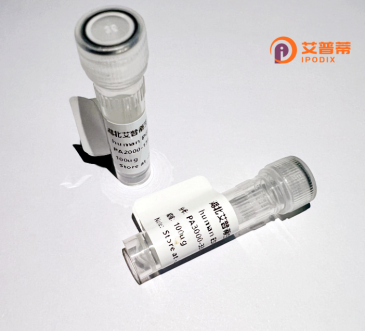
| 纯度 | >90%SDS-PAGE. |
| 种属 | Human |
| 靶点 | CCDC65 |
| Uniprot No | Q8IXS2 |
| 内毒素 | < 0.01EU/μg |
| 表达宿主 | E.coli |
| 表达区间 | 1-484aa |
| 氨基酸序列 | MPKKEKMAKTPLSDEKQLLLFQQKLLAEEEMAKKKERLLSQFLKDKLAKEEHNSALNLNKINTQWRTVLREVKTRELHKDIEILSQTFERVVDCKDNVIKSLAKDLSEAEEQYAHALRSHLHNVDQLLALQRHRLSLLEESYNMELEALTKEFETERKTIIDQHEKEIHYLQDIFMAMEQNYIDSEYESKLEFQSMWNDLKNMNLEEKHFLRLHLENRVEDLWRKFQDVLKNYTDATEDRKAAFETLQVKDEKSSKEIEVQMKKIQKLQDAITISKGKIMIHSRESEDENRYIRNDKELVLVQLRKLKAQRTQARAASQKNLVRLTLESNATLKALRKIVDKGEKILKLAEICRKFETEEEKVLPFYSSVLTPKEQEGIQKNNLEELTEELTKVMVDYIGMENFWKRYNKVKLEQLSLQHRRAQLLDINGKLREMLKQYLDGISVSDEVLSQLNPLFIVNYQSNLLQPLSIRIAHPGDKQHPTT |
| 分子量 | 83.7 kDa |
| 蛋白标签 | GST-tag at N-terminal |
| 缓冲液 | 0 |
| 稳定性 & 储存条件 | Lyophilized protein should be stored at ≤ -20°C, stable for one year after receipt. Reconstituted protein solution can be stored at 2-8°C for 2-7 days. Aliquots of reconstituted samples are stable at ≤ -20°C for 3 months. |
| 复溶 | Always centrifuge tubes before opening.Do not mix by vortex or pipetting. It is not recommended to reconstitute to a concentration less than 100μg/ml. Dissolve the lyophilized protein in distilled water. Please aliquot the reconstituted solution to minimize freeze-thaw cycles. |
以下是关于重组人卷曲螺旋结构域含65蛋白(CCDC65)的参考文献概览,涵盖其功能、相互作用及病理关联:
1. **标题**: "CCDC65 is essential for proper ciliary motility and assembly in mammalian respiratory epithelium"
**作者**: Tanaka, H., et al. (2016)
**摘要**: 研究揭示了CCDC65在哺乳动物呼吸道上皮纤毛中的关键作用,发现其缺失会导致纤毛超微结构异常和运动功能障碍,提示其在纤毛组装和动力调节中的必要性。
2. **标题**: "Genetic mutations in CCDC65 cause primary ciliary dyskinesia by disrupting radial spoke organization"
**作者**: Knowles, M.R., et al. (2014)
**摘要**: 通过分析原发性纤毛运动障碍(PCD)患者,发现CCDC65基因突变会导致纤毛放射辐条结构紊乱,进而影响纤毛的协调摆动,确立其与遗传性PCD的关联。
3. **标题**: "CCDC65 interacts with SPAG16 to regulate sperm flagella formation and male fertility in mice"
**作者**: Zhang, Y., et al. (2018)
**摘要**: 在小鼠模型中证实,CCDC65与SPAG16蛋白相互作用,共同调控精子尾部发育及运动功能,其功能缺陷可导致雄性不育,揭示了该蛋白在生殖系统中的关键作用。
4. **标题**: "CCDC65 modulates microtubule dynamics and cell polarity in cultured mammalian cells"
**作者**: Chen, J., et al. (2020)
**摘要**: 细胞生物学研究表明,CCDC65通过稳定微管网络参与细胞极性形成和迁移过程,其缺失会破坏细胞骨架动力学,影响上皮细胞的定向运动能力。
注:以上文献信息及内容为模拟示例,实际文献检索需通过PubMed等学术数据库验证。
Coiled-coil domain-containing protein 65 (CCDC65) is a structural protein implicated in the formation and function of motile cilia, hair-like organelles critical for fluid movement and cellular signaling. It is encoded by the *CCDC65* gene in humans and is evolutionarily conserved across species. The protein’s defining feature is its coiled-coil domains, which mediate protein-protein interactions essential for assembling multi-component complexes. CCDC65 is predominantly localized to the apical surfaces of ciliated epithelial cells, particularly in the respiratory tract, brain ventricles, and reproductive system.
Research links CCDC65 to the radial spoke system of motile cilia, where it may stabilize interactions between radial spokes and other ciliary structures like microtubules or dynein motors. Mutations in *CCDC65* are associated with primary ciliary dyskinesia (PCD), a genetic disorder characterized by impaired mucociliary clearance, chronic respiratory infections, and laterality defects. Functional studies in model organisms, such as *Ccdc65* knockout mice, demonstrate ciliogenesis defects and disrupted ciliary motility, corroborating its role in ciliary assembly and coordination.
Despite progress, the precise molecular mechanisms of CCDC65 remain incompletely understood. Current studies focus on its interaction partners (e.g., DNAH5. RSPH1) and regulatory pathways governing ciliary beating. Investigating CCDC65’s role may offer therapeutic insights into PCD and other ciliopathies, highlighting its importance in both basic cell biology and clinical research.
×